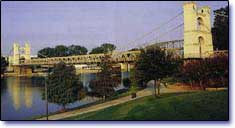

Slavery in Waco
Slaves in the Shadows of the Past | Slavery Must Be Faced | Growth of Slavery | Aspects of Slave Life
Slaves in the Shadows of the Past: The Institution Was No Stranger to the Waco Area in the Mid-1800s
Slavery in Waco, Part 1 of a series
By: Karla Price
Although slavery arrived much later in Texas than it did in many other Southern states, the institution was certainly no stranger in Waco and Central Texas in the mid-1800s.
Slaves were with the founders of Waco from the beginning of their journeys across the South. The first of those settlers was Shapley Ross, who came to Waco in March of 1849 and bought much land.
The Ross family, with the help of other settlers, built the first home in Waco. Ross and his wife, Catherine, brought with them two slaves, Armstead and Lucindy, who are listed as two of the original 21 settlers of Waco, according to Patricia Wallace, Baylor University associate professor and historian.
Other families, including the McLennan’s, the Walkers, the Eraths and the Earles, brought their slaves with them when they settled in Waco in the early 1850s.
The fertile land of Central Texas attracted many of Waco's first settlers from the Deep South, said Waco historian Roger Conger.
"While lots of Texas in frontier days was cattle country, McLennan County was actually a planter culture, because the leaders who came here in the 1850s, which was the first decade of Waco history, were almost all, even the lawyers, from a planter culture over in Alabama, Mississippi, Georgia and elsewhere," he said. "The rich soil of the Bosque and Brazos rivers was an attraction.["]
"It was a wonderful opportunity for these planter people, so they opened up these big plantations in the 1850s, and of course most of them brought slaves with them from Alabama and Mississippi," Conger added.
"The growing value of cotton as a cash crop was another factor in the rise of
Slavery in McLennan County.["]
"Cotton had become king in the very earliest days," said Conger.
In the 1850s, the mean crop of cotton per farm increased from 3.3 to 10.4 bales during the decade, a gain of 215 percent, wrote Planters and Plain Folk authors Richard Lowe and Randolph Campbell. In Central Texas, 2,095 400-pound bales of cotton were produced in 1850. By 1860, that number had grown to 18, 43? 400-pound bales.
More and more Central Texas planters began to buy slaves to harvest their crops and work in their homes.
"You might say one's prosperity among people who were in the planting business was driven by his investment in slaves as were as livestock, such as cattle and horses," Conger said.
By 1860, McLennan County had a white population of 3,799 and a slave population of 2,404, which was worth more than a million dollars. Leading slave owners included the Downs family, whose plantation was in east central McLennan County, and the Dechard family.
Another very successful Waco plantation owner was James Harrison. In 1858, Harrison, a Mississippi planter and ex-member of the Mississippi House of Representatives, came to Central Texas and bought 6,000 acres on the east side of the Brazos River, 10 miles south of Waco, to grow cotton, according to author Jay Butler. His plantation was called Tehuacana Retreat, after the Tehuacana Creek that ran through his property.
In 1860, Harrison owner 41 slaves, according to the McLennan County Census.
However, tension was rising between the slaves and their owners as the decade ended. For example, eight of the 41 slaves owned by Harrison were listed as fugitives from the state in the 1860 Census.
Tension not only was growing between slaves and their masters, but between North and South as well. The North boasted a strong anti-slavery movement. If there was opposition among whites to slavery in Texas and in Waco, it was silent. And the silence may have been the product of fear, said Baylor University professor Stanley Campbell.
"In 1827, long before Texas became a state, there were over 100 anti-slavery societies in the South. By 1833, there were none," he said.
"It was largely because of the reaction to the abolitionist movement. After the Nat Turner rebellion that occurred in Virginia in 1831, the Southern slave states really clamped down; thereafter, it was dangerous to be an abolitionist in a slave state.["]
Of course, the battle over the right to own slaves contributed to the secession of the South from the Union that led to the Civil War. James Harrison served as a brigadier general in the Confederate Army. A few months after Robert E. Lee's surrender to Ulysses Grant at Appomattox, Harrison expressed concern about how the war would change his life and the lives of his slaves in a letter to son John on June 18, 1865:
"There is one thing certain, that our negroes are to be freed. I am sorry for them -- they will experience the most bitter want and poverty. Unaccustomed to manage for and control themselves they will buffeted from one point to another, until famine, wretchedness and despair will seize them. (I have) decided to take care of, and provide for mine if they will stay, behave themselves and work. All this they must do or leave, for I shall be poor and unable to support them if I am permitted to remain in the Country at all."
The rise and fall of slavery would bring about radical changes in the course of the United States. Whether one viewed it as a negative or positive difference, most would agree it was the end of a way of life, for both blacks and whites.